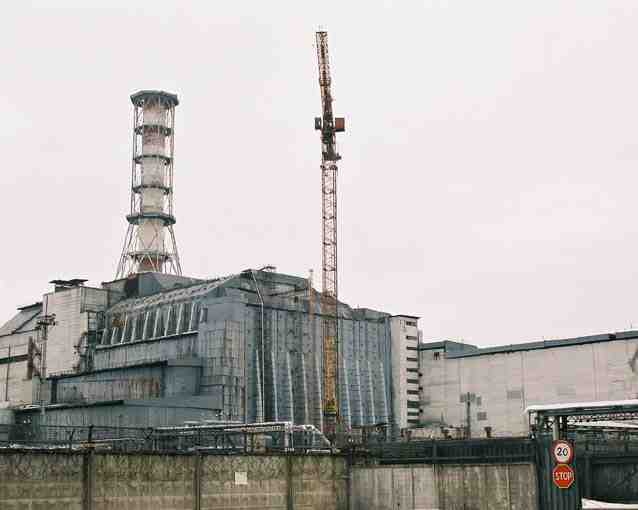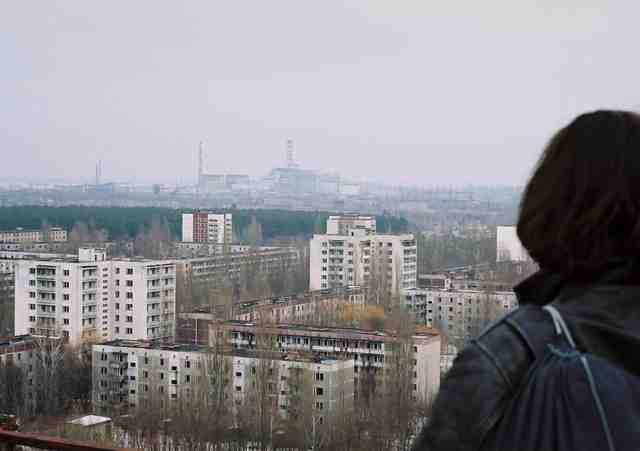
Today (and yesterday) is the 20th anniversary of the Chernobyl disaster. A nuclear power plant in the middle of a crowded city of over 100,000 people exploded and melted down. Thousands are believed to have died, although the exact number is unknown. 100,000 were evacuated. The old Soviet Union still stood, and information was suppressed from the outside world.
Reading about Chernobyl, all I can think about is our insane President and his nuclear threats. He's already started a war because he wanted to, with no real justification; I see no evidence that he has any concern for the real-world consequences of a nuclear strike. It's just another piece on the checker board. (I'd say chess board, but he's not that smart.)
Ghost Town
I saw a link to Ghost Town in the comments section on Booman Tribune. The site was set up by a woman named Elena Filitova who remembers being evacuated from the area as a small child. She goes back, riding her motorcycle and carrying a geiger counter, which she holds up in many of the pictures to show what the dosage is at that location.
There are questions about the legitimacy of her story. Wikipedia and last year's New York Times Chernobyl tourism article give different stories as to how the pictures were taken. Still, the photographs are definitely in the poisoned area, and they are instructive.
The pictures really let you see what a large and populated area this was and how it is now, as Filipova describes it, a modern Pompeii, where disaster has made time stand still. It is always April 26, 1986 in Chernobyl and it will always be. From Chapter 2:
Dad is nuclear physicist, and he has educated me about many things. He is much more worried about the speed my bike travels than about the direction I point it. My trips to Chernobyl are not like a walk in the park, but the risk can be managed. It is similar to walking on a high wire with a balancing pole. One end of the pole is the gamma ray emission intensity and the other end of the pole is the exposure time. But the wire is also covered with a slippery dust, and this is the major risk. I always go for rides alone, sometimes with pillion passenger, but never in company with any other vehicle, because I do not want anyone to raise dust in front of me.
Dad and their team have worked in the "dead zone" for last 18 years doing research about the day it all happened. The rest of the team is comprised of microbiologists, doctors, botanists and other professions with long names and many syllables. I was a schoolgirl back in 1986 and within a few hours of the accident , dad put all of us on the train to grandma's house. Granny lives 800 kms from here and dad wasn't sure if it was far enough away to keep us out of reach of the big bad wolf of a nuclear meltdown.
The Communist government that was in power then kept silent about this accident. In Kiev, they forced people to take part in their preciously stupid labor day parade and it was then that ordinary people began hearing the news of the accident from foreign radio stations and relatives of those who died. The real panic began 7-10 days after accident. Those who were exposed to the exceedingly high levels of nuclear radiation in the first 10 days when it was still a state secret, incuding unsuspecting visitors to the area, either died or have serious health problems.
NYTimes: First at Chernobyl, Burning Still
The Multimedia section of this article is chilling. Click on the section titled "Liquidators". That's what they called the people called in to clean up the mess, to liquidate the problem. They all had high radiation doses. I found the statement of fireman Leonid Shavray (last picture on the right) moving:
Our watch went on duty on the 26th. At 1:23 there was an explosion. The building shook. I didn't understand at first. There was one pop, then another, then the siren went off. Our unit was opposite the atomic station. We jumped up and we couldn't see the ventilation pipe. There were no pipes, as if they had been blown away. And there was a mushroom-shaped sphere. From below a flame. And above a mushroom cloud.
In three minutes we were at the station. There was such a rumble. It was broken glass below our feet. It was such a state that your hair even stood on end. We saw the personnel running around. They said the fourth block blew up, the roof is burning. We parked the cars and climbed up. The temperature was so high. True, what helped us is that the wind was blowing not from the station towards us but towards the station. At about 4:00 a.m. or 4:30, our replacements came.
We went down. I smoked a bit. There was a sweet taste. Prischepa was already nauseous. We were so thirsty. We drank water and we started throwing up. We went to wash. The alarm goes off. Wash again. Same thing. We lay down and were dizzy.
On the 30th we were hospitalized in Ivanokovo. We spent 24 hours there on IV. Then we went to Lomonosovo, to the hospital. I'd fall asleep and they'd say, "Don't sleep, don't sleep." And they pumped us like that at night. Our hands hurt. I.V.'s, I.V.'s, washing the blood. They gave me a bone marrow transplant. Thank God, I lived.







1 comment:
interesting
Post a Comment